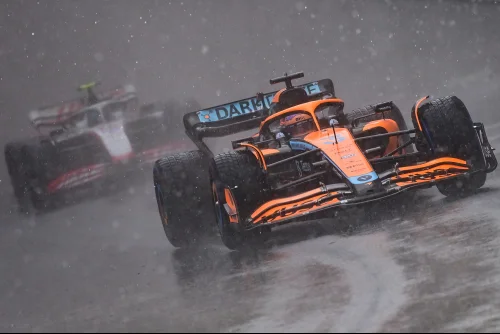
A few months ago, I started driving F1 circuits, including Spa-Francorchamps, Monza and Suzuka. I’ve driven dozens of exotic cars from the Porsche 911 GT3 to the Alpine A220 and the Ferrari F50. That is, I’ve driven them virtually via Gran Turismo (GT7). GT7 is a racing simulator that, with the wheel and pedals, is as close as I’ll likely ever come to driving the real things. F1 teams have their own versions of this simulator (worth hundreds of thousands more, of course) that they spend countless hours training on when they’re off the track.
Nearly everything about the art of racing can be applied to business. Here are four racing lessons that can help you accelerate your career.
1. Overprepare
F1 racers know the track. They can drive it in their sleep. Indeed, they do. Here’s Red Bull’s Sergio Perez driving Autodromo Hermanos Rodriguez virtually in advance of the 2022 Mexican Grand Prix with his back to the screen and his eyes shut, on a dummy steering wheel. Perez came in third at the Mexican Grand Prix. That’s how much preparation goes into each F1 race. His teammate, Max Verstappen, earned the top podium spot, finishing 17 seconds ahead of him.
When I look back at the first 30 years of my career, there is one common denominator among my most successful articles, pitches and campaigns: I was overprepared. I didn’t just wing it. I spent an abundance of time on research, asked questions, and jotted down notes and ideas. I didn’t earn gold on any of the GT7 tracks on my first try. In fact, it took about five laps around just to get a good feel for it, and then another 10 or so to get it right. Show up overprepared and your odds of success improve exponentially.
2. Go slow to go fast
“Slow in, fast out” is one of the first lessons race car drivers learn. Anybody can drive fast in a straight line; it’s how you handle the turns that make you a great racer. The long straights at Monza make it one of the fastest circuits in all of F1, but a long straight is oftentimes followed by a series of two turns (a quick left then right, for example) called a chicane. It’s here where drivers typically make up (or lose) time. Navigating a chicane is a skill in itself, as it requires driving somewhat slowly through the first half in order to take the second half at full speed.
All turns are not created equal and knowing which is most important requires a keen sense of prioritization. Slow in, fast out, is the driving equivalent of “playing big” — focusing on the bigger picture, rather than on the minutia. Slow work means more thoughtful, creative work which can help you “play big” in your career. And that ability to slow down can catapult your business when you least expect it.
3. Know your brake (break) point
Any racer worth their salt can tell you with pinpoint accuracy exactly where every single one of the brake points is on each turn of a circuit. For each driver, the brake points are different and depend on a multitude of variables: driver ability, the car’s capability, condition and wear on the tires, and even how much fuel they’re carrying. Finding the brake points is key to going faster and winning a race.
As a professional, you have your own break points, and these, too, are based on a variety of things: how many hours you’ve put in, how much stress you’re under, whether you’re hungry, tired, etc. Break too early, and you risk losing all of your momentum, but break too late — or not at all — and you’re likely to crash. Most of us learn this the hard way. Don’t want to crash and burn? Learn to build breaks into your schedule when you need them. It’s not only critical for your mental health but imperative for your physical health. Unless your goals include panic attacks and migraines, find your break points.
4. Follow the racing line
We all know that the white and yellow lines painted on every road are meant to keep cars from crashing into one another. What you might not know is that the optimal driving line rarely follows those painted lines. I’m not advocating that you ignore the rules of the road. But when you put an F1 driver on the road, they don’t see the paint, they see the racing line.
That’s because going as fast as possible requires going as straight as possible. The curves are the challenges the drivers must overcome. This is why you see the F1 drivers using the entire track from edge to edge.
Racers know that the best lap times result from creating the straightest possible line around the circuit. Twisting and turning costs precious time. You might temporarily get ahead, but without following the proper line, I guarantee you’ll end up at the back of the pack.
For marketers, this might mean appealing to your audience wherever they are along the buyer’s journey. For manufacturers, completing each step of the process ensures quality craftsmanship. Whatever your role, industry, or vertical, don’t succumb to shortcuts. Use the entire track (and every tool at your disposal) and follow the proper process.
You won’t beat your competitors by taking shortcuts, you’ll beat them by being a better driver. Learning how to navigate the twists and turns of your professional journey will help you stay focused, accelerate your career and position you for success.
This article was originally published by Entrepreneur.


